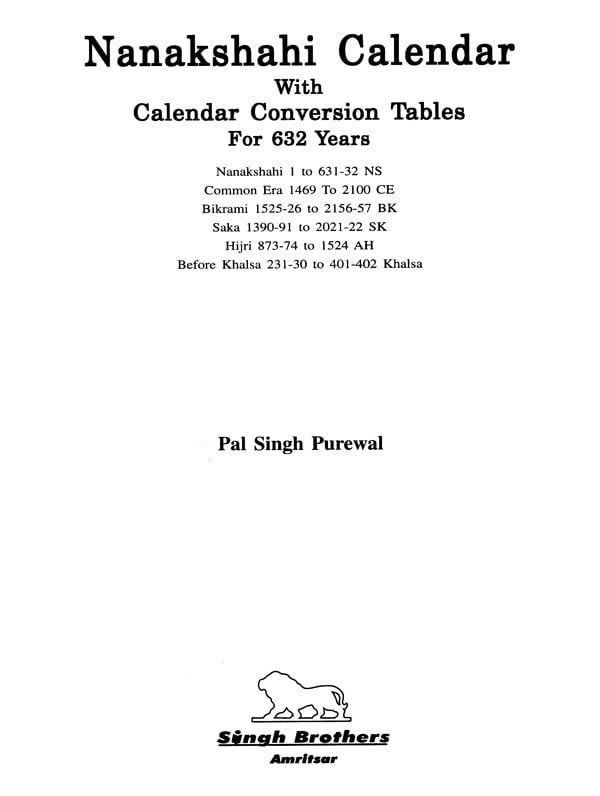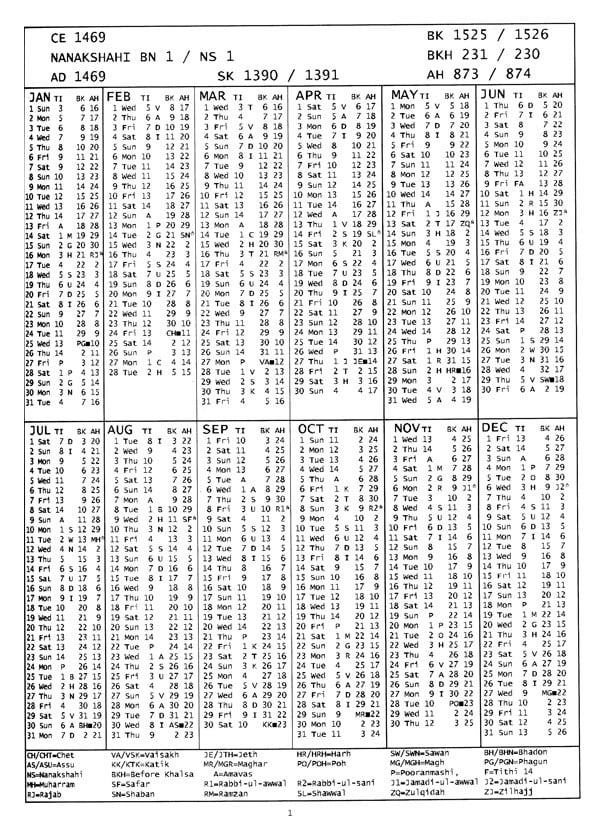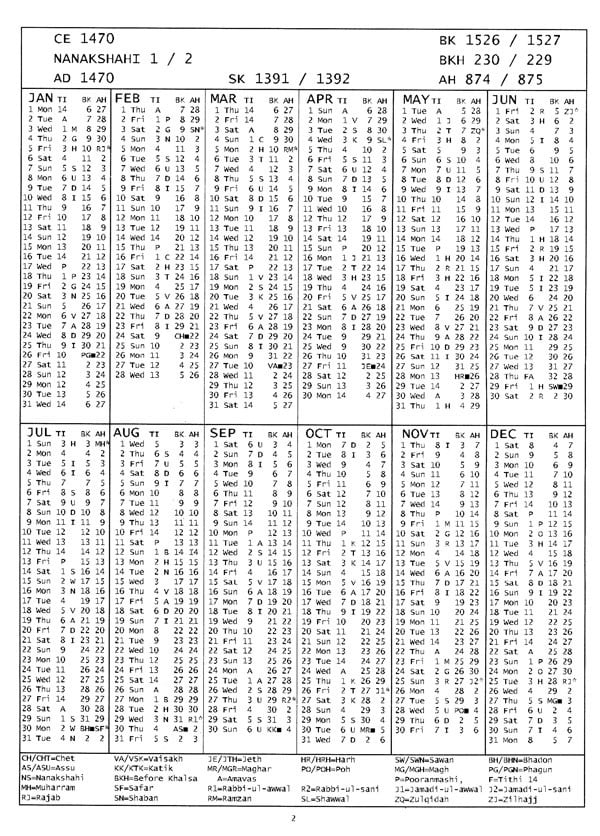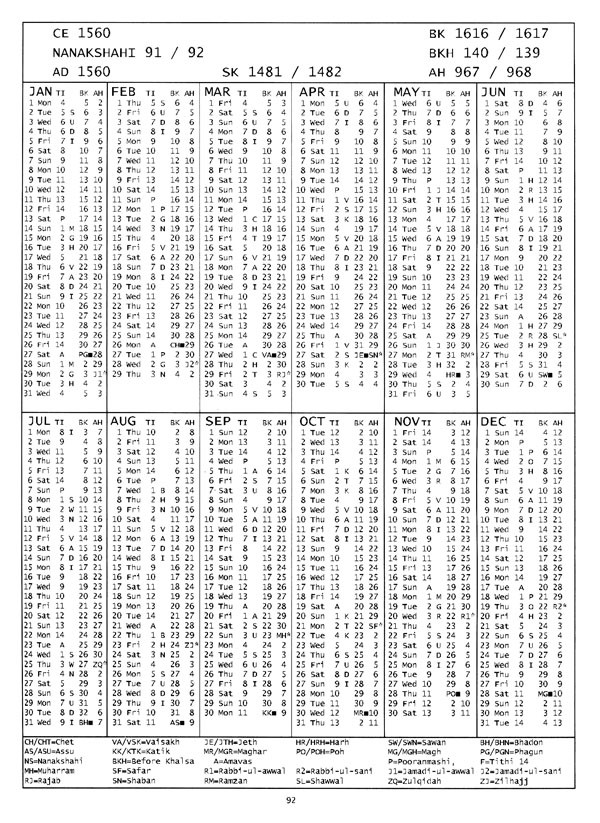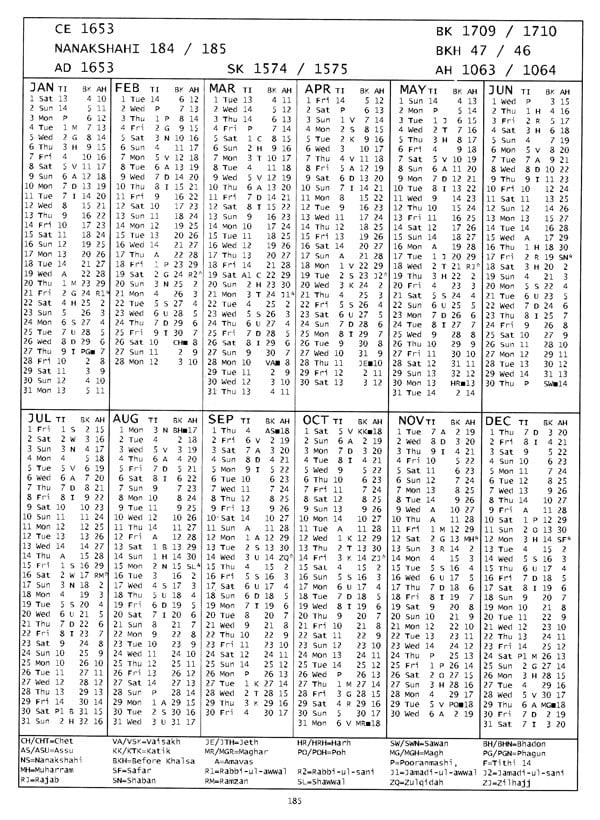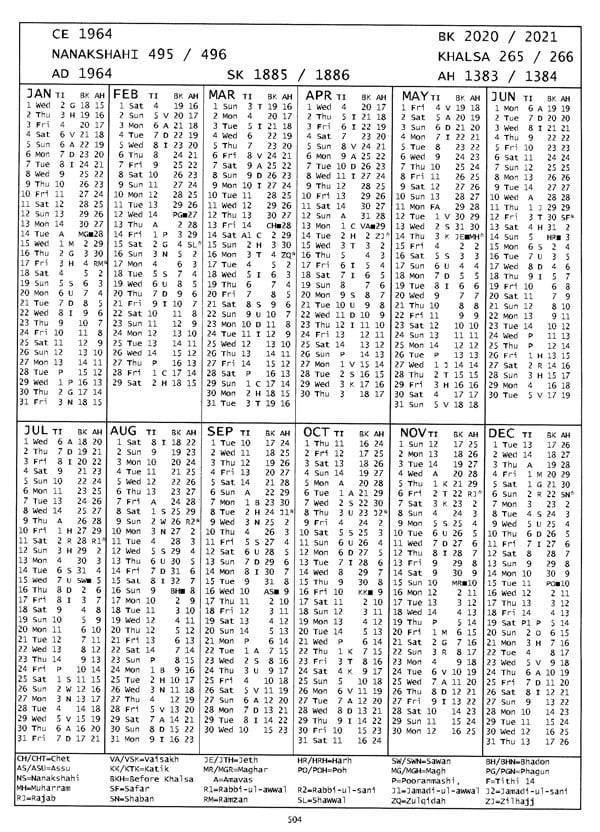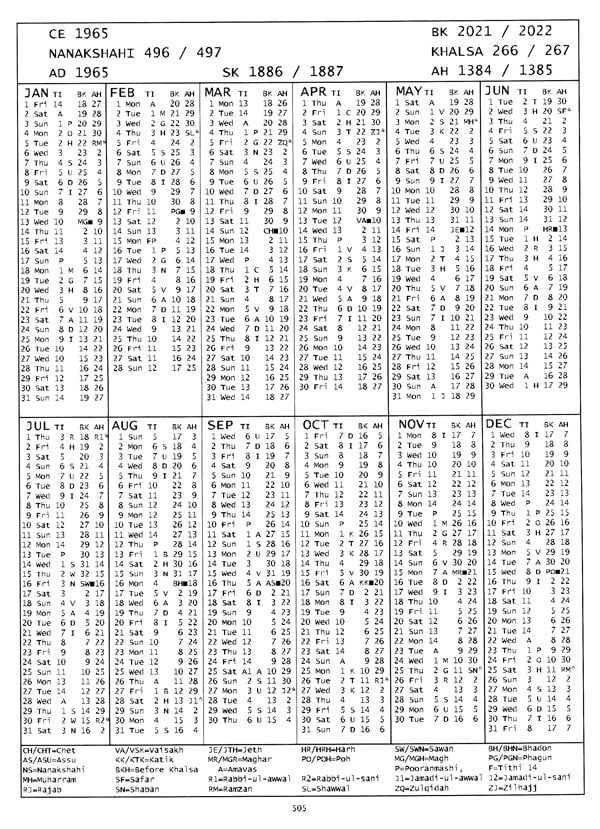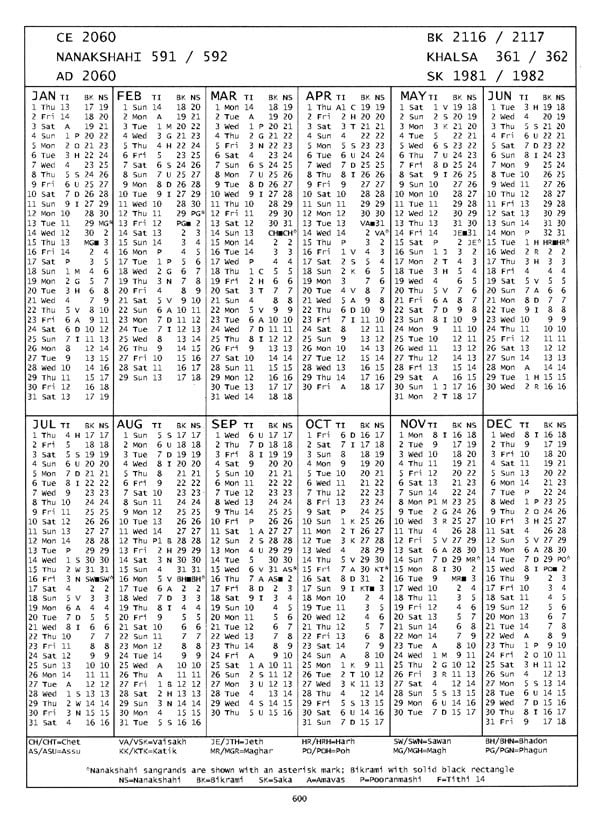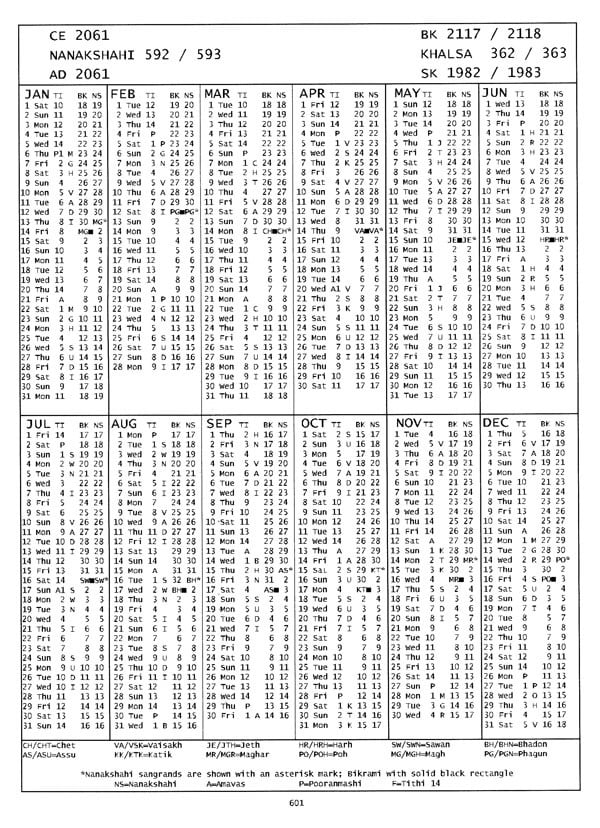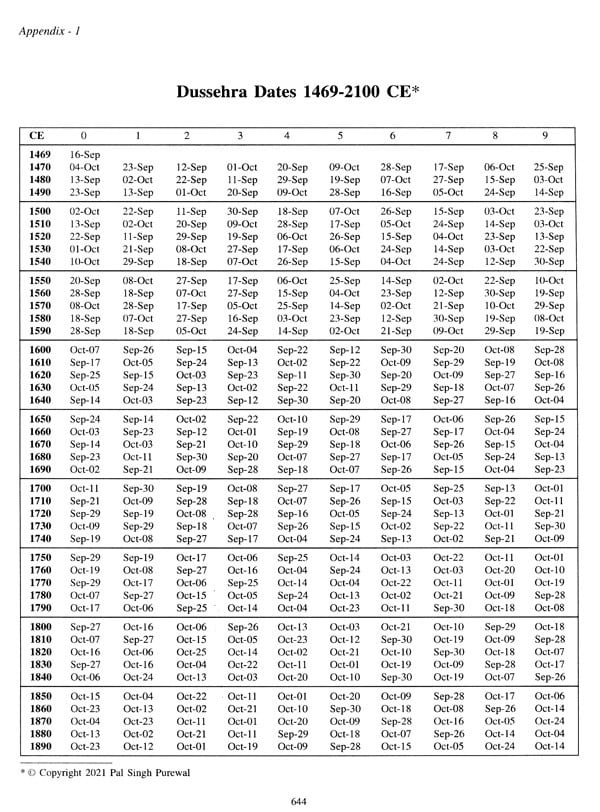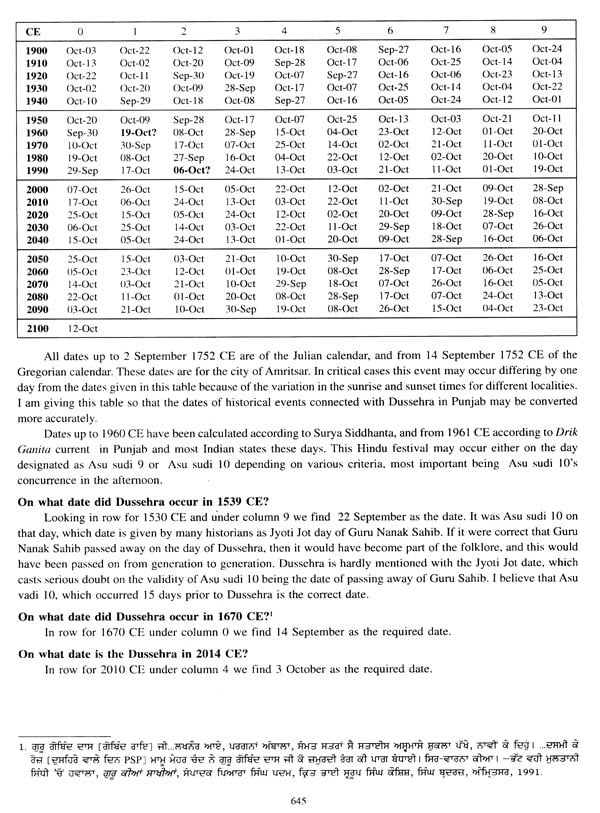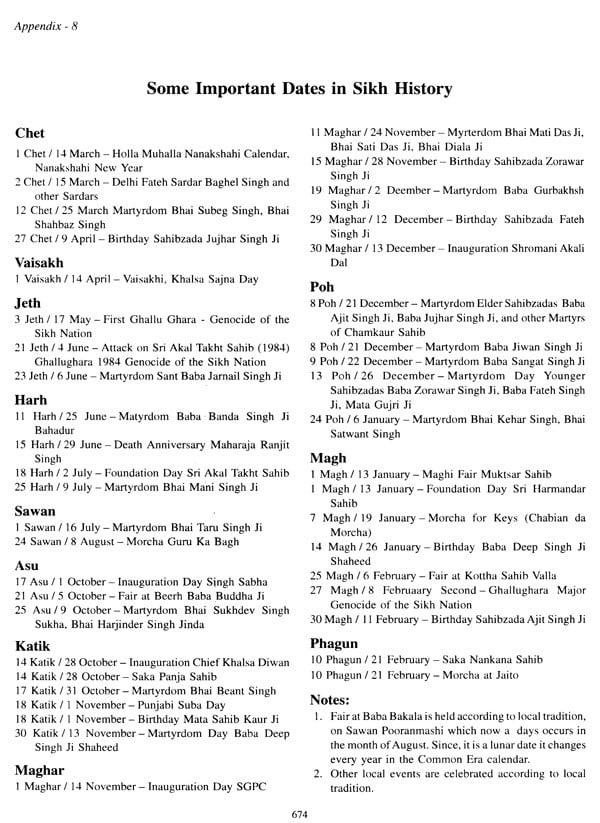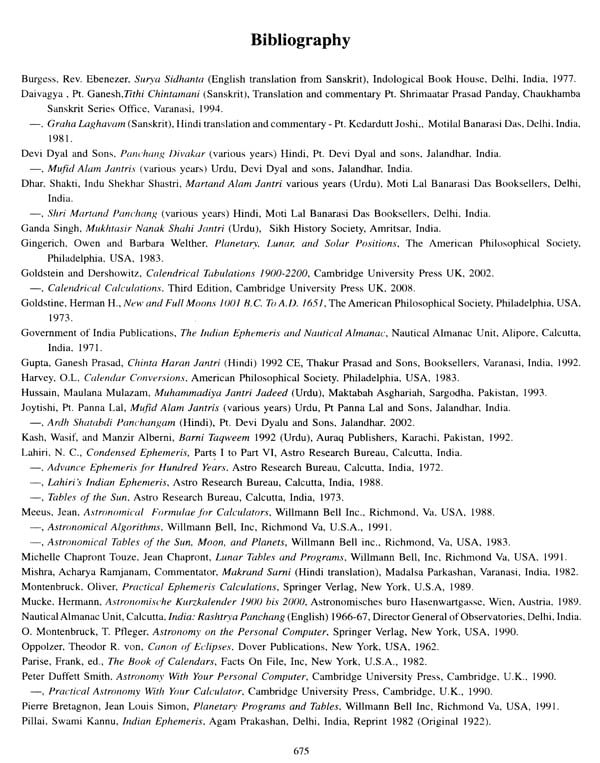About the Book The book describes the development and implementation of the Nanakshahi Calendar. This is a solar calendar based on the length of the tropical year, and is according to Gurbanee. It is simple and scientific calendar for the Sikhs. If the months of a calendar must have constant relationship with the seasons then its length must conform to the length of the tropical year. All gurpurb and historical Sikh dates given are fixed and its months do not wander in the seasons. Old Nanakshahi calendar followed the Bikrami calendar up to 1998 CE whether it was according to Surya Siddhanta or Drik Ganit. New Nanakshahi Calendar dates are given from 1999 CE to 2100 CE on daily basis. The calendar adds to the identity of the Sikh nation.
Tables for 632 years, from 1469 CE to 2100 CE have been provided on daily basis for mutual conversion between the dates of Common Era, Bikrami Samvat, Saka Samvat, and the Hijri Sann (Era). It is a very useful tool for the historian working with the documents concerning the medieval history. It has been found to be more accurate than some other available works.
Tables for Dussehra, and Divali dates for 632 years have been provided to help accurately fix the dates of events that took place or are planned to take place on those fairs. Swami Kannu Pillai's Indian Ephemeris has been discussed as to its suitability and otherwise for Punjab. To help understand the calendars, definitions. of terms used in them have been provided. The divisions of the day from sunrise to sunset are explained.
And finally, a calendar for 3000 CE is provided as a treat for the reader, and to show how dates of events remain unchanged from year to year in Nanakshahi Calendar while they drift in the Bikrami Calendar.
About the Author Pal Singh Purewal migrated to U.K in 1965, after a few years of teaching in Punjab. He worked for Texas Instruments Ltd. Bedford, and rose to the position of Senior Engineer. On TI assignments, he travelled to Germany. USA and El Salvador. In 1974 he emigrated to Canada, where he worked as Manager Data Processing Department, and Director with Miller Office Group, Edmonton, Alberta. In 2003 he was awarded Queen's Golden Jubilee Medal for community service. He is the Chief Architect of the Nanakshahi Calendar and has presented many research papers at international foras.
Foreword Making an almanac is a highly technical and intricate issue, which requires mastery over the subjects such as mathematics, astronomy, geography, history, religion, and culture of the people concerned. A cursory glance over the civilation of humankind confine shot calendars of varies bes have been in vogue in different continen countries, gros cultures, and religious communities. In a cuturally diverse country like fadis until 1957, people had experienced more than thirty different calendars in measure the day, the, and year, besides arriving at the dates of religious festivals of the Hindes, Buddhists, fans, etc. These calendars are luar or solar and have heen used a different stages of history by various regimes and commmmitues of tedia. Another point of reference which has played a predominant role in making almanacs, relates to the change in seasons. The occurrence of the vernal equinas (the beginning of spring) has been of crucial significance as it also determines the fall of succeeding There is no denying that with time some of the Indian calendars have fallen into oblivion, but it couple of them are still prevalent In India, the Bikrami and Saka eras find their mention in traditional and official calendars The Bikrami era, which began in 57 BCE, owes its origin to King Vikramaditya, who ruled over Malwa with its capital in Ujjain Almost all the dates in Hindu history occur, according to this era. It has survived till today because has been widely used even after the British introduction of the AD calendar The Saka sammar, which began in 78 CE traces its origin to a Saka king. Salvahina. It was reformed by the Calendar Reform Committee constituted by the Government of India in 1952. On the recommendation of that committee, it was adopted as an official calendar by the Indian Goverment in 1957. The year of the Saka era synchronises with the length of a CE year and thus maintains a constant relationship with it. Unfortunately, it has failed to catch the imagination of the people. Though it is a national calendar of India, no scholar or historian refers to it except for its mention in official dispatches Undoubtedly, the Bikrami calendar traces its origin to ancient times, yet it has undergone changes at different stages of its history, It is a luni-solar calendar. Le. lunar and solar movements are taken into account for arriving at the dates of vital importance. The Hindu science of almanac making is known as panchang, ie, panch angas, meaning five limbs of time division viz. vara (day), tithi (date), nakshinra, yoga and karana. It is based on the sun and the moon and takes into account the waxing and waning of the moon, the position of stars and planets and determines the auspicious days and times for various ceremonies. The length of a lunar month is equal to the time taken by the moon from new moon to new moon or full moon to full moon. The average of this cycle is 29 days. 12 hours, 44 minutes, and 3 seconds approximately. Twelve such months make a lunar year which comprises 354 days, 8 hours, 48 minutes and 36 seconds approximately. Obviously, a lunar year is 10/11 days shorter than a solar year. Therefore, an extra month known as mal/adhik/laund month is added approximately every 32 months to keep the lunar year synchronized with the solar year. As this month is considered inauspicious, no religious ceremony or festival is celebrated. We observe that the dates of festivals, such as Diwali, Holi, and the dates associated with the holy deities do not synchronise with the dates in a solar year but continue to move back and forth due to this intercalary month.
Preface My interest in astronomy in general and extendrical strony in particular spans over a period of more than half a century. During early eighties I embarked upon the study of Sikh history and the history of Punjabs from an entirely different perspective via the validity of dates mentioned by various authors and the conectness of conversion of indigenous calendar dates to the conespending dates of the Christians Era, now also known as Common Era: Some of the mod learned authors and scholars have made glaring errors of calendar conversions. In one case a date has been woigned to a solar cetime at Kurukshetar which did not occur on that date The main reason for these errors was lack of availability of simple almanacs (Jantrin) for earlier periods Historians and scholars had to work their way from tables ges basic data and do some calculations to arrive at the correct conversion Indian Calendars by Sewell and Disit gave tables with data for the beginning of solar and lunar years of the Hikrami calendar and auxillary tables to calculate and convert any other date of the year S, Karam Singh Historian used this book to conven the parkash gurçadili and jo jot dates of the ten Sikh Guru Sahiban. In spite of his expertise, he made some errors in calculations and his results were out by one day in those cases. The other major work The Indian Ephemeris by Swami Kannu Pillai was extensively used by historians, including Dr. Ganda Singh, without being aware of its limitations. The main tables which show corresponding dates on daily basis of Bikrami Common Era, and Hijn calendars for each year, give solar dates of the Bikrami calendar based on Arya Siddhanta, and not the Surya Siddhanta used in northern India. Further, the date 1 of the solar month is on the same day as saran day (Punjab rule). But it could be on the next day in Tamil Nadu if the sankranti time is after sunset (Tami Nado rule) This resulted in half of the converted dates of the solar calendar to be out by 1 when compared to correct calculations based on Punjab usage (day I of the month is on the day of sankranth). This is the reason why Dr. Ganda Singh's date of 30 March 1699 CE for 1 Vaisakh 1756 BK is incorrect. It is Tamil Nadu date of Arya Siddhanta Sankaran of Vaisakh, Vaisakhi, according to Surya Siddhanta, Punjab usage, and also according to Arya Siddhanta, was on Wednesday, 29 March, 1699 CE Julian calendar). Dr. Ganda Singh, while working on his research projects on Sikh history, compiled the dates of beginning of the solar Bikram years in relation to the Common Era calendar from 1469 CE to 1949 CE. For these dates he gave the Hijri calendar dates and the tithis (lunar dates) of the lunar months of the Bikrami Era. He published his tables called Mukhtasir Nanak Shahi Janiri in Urdu language. In this almanac he also gave a table of intercalary months. There are inaccuracies in the main table, and some omissions in the table of intercalary months. Moreover, since the corresponding dates for Vaisakh I only are given for each year, the Jantri is of little help to researchers working with wide spectrum of dates.
The present work covers the period from Nanakshahi I to Nanakshahi 631/32, 1469 CE to 2100 CE, Bikrami 1525/26 to Bikrami 2156/57. Dates of these calendars along with the week days are given on daily basis. From 1469 CE to 1968 CE Bikrami dates are according to Surya Siddhanta, and from 1961 CE to 2100 CE the calculation is according to Drik Ganit. From 1999 CE Nanakshahi dates are given in a separate column based on the new Nanakshahi Calendar. The dates of the Hijri calendar for Hijri 873/74 to Hijri 1418/1419 are given on daily basis, and then up to 2100 CE in a separate ta
Introduction This the perod from 1469 CT so 2100 Cigal law des for Band Old Nendhhi tester has bee eldsted for the dry of Ant From 1900 CE 2100 CE the silar Namakahah daes have been given occording to the sidebar spped by Sesa Aka first in This has been done to reproduce, as close as possible, the Bike tone and solar calendars that pervaded during the period in question. My model alma makers realising the and deficien to the neglect of my terms in the formulas of the Surya Siddhanta vouched were, during the nineteen sisters, to the formulas of the modern astronomical theory called Drat Ganit Consequently, 1961 CT to 200 C according to this system lacerated readers may compare the calendars for the overlapping years 1961 C to 1908 CE calculated in both systems Nanaksha solar calendar dates have been given from 1999 CE to 2100 CE for each day so that the discerning readers may compare Bikram and Nanakshi solat dans and see for themselves how the Baram atrunde shif in Gregorian calendar. Buni dates which had been given for each day in my earlier work Jars 500 Years for historical purpose, have been discontinued from the mam ubles for 1999 CE-2100 CL but a separate section giving the date of beginning of each Hijr month in the 21st century is included All nithir Omar days), poorammes (full moons), sharyas (new moons) are those ta are current at the time of sunrise at Amritsar. The rk would be the same in most places in central, western and northwest India. except in critical cases when the change of tithe occurs very close to the sunrise time. In such cases the athi may differ by 1 at different places For determination of this and sankrantz (first day of the solar month) the day has been considered to begin with the sunrise, as was and sall is the practice among the indigenous almanac makers. Therefore, for example, if a sankranti occurs at 2:00 am on 14th April, it is shown as occurring on 13th April, because the event has happened before the next sunrise. According to Punjab rule, day 1 of Bikrami Vaisakh would be on the same day as of sankrant Le in this case on 13 April. However, From 1999 CE onwards Nanakahahu day is considered from midnight to the following midnight.
Common Era:
The Christian Era abbreviated as AD or BC, now a days is more commonly known as Common Era abbreviated as CE or BCE, as the case may be, since the adoption or parallel use of its calendar in most countries of the world. Its ordinary years have 365 days and leap years 366 days. The number of days in each month are fixed. February in a leap year has 29 days but in an ordinary year has 28 days. Prior to 1582 CE the leap year rule was: if a year was divisible by 4 without remainder it was a leap year. This gave an average length of 365. 25 days in a year. This length is a little more than the length of the solar tropical year of very close to 365, 2422 days. Therefore, the beginning of the year in the Julian Calendar, as it was called, occurred a little later every year in relation to the tropical year on which the cycle of seasons depends. In the year 325 CE the spring equinox (day and night equal) occurred on 20 March but because of gradual advance of the beginning of Julian year spring equinox occurred on 10 March, 1582 CE. Julian calendar was getting out of step with the seasons. Pope Gregory on the recommendation of a committee of experts introduced the reform to the Julian calendar, wemoving this discrepancy and altering the leap year rule.
**Contents and Sample Pages**
